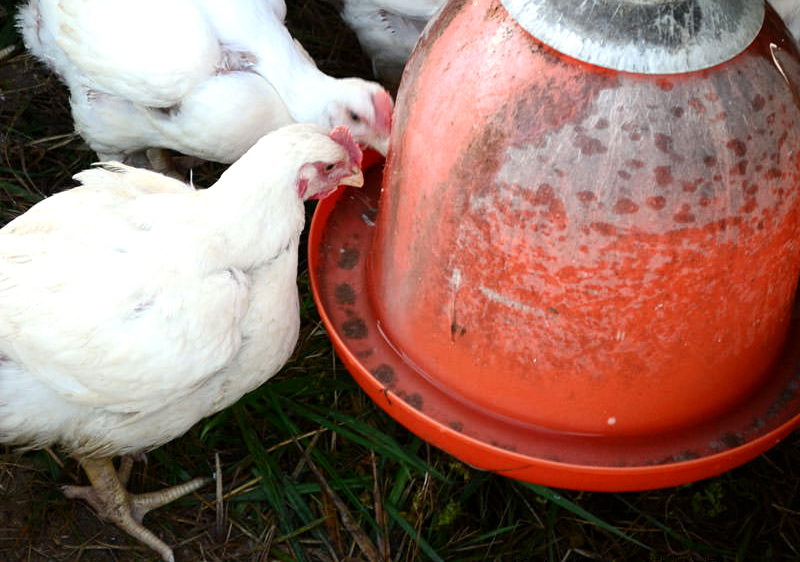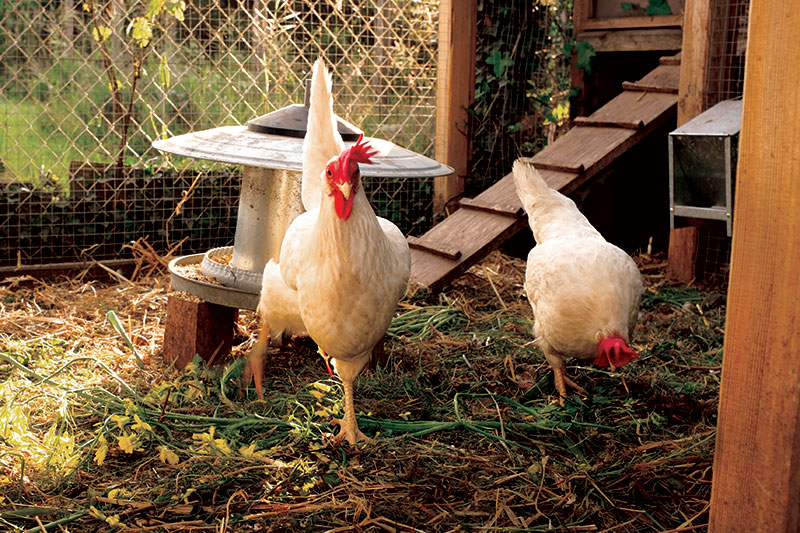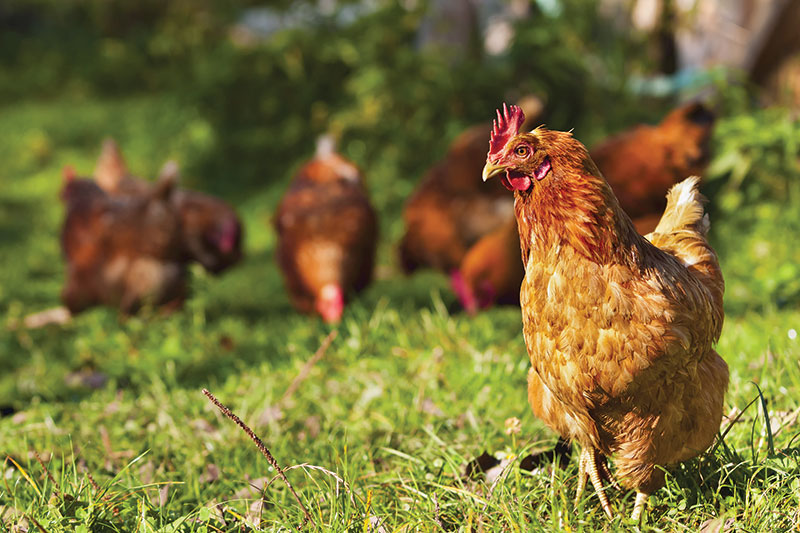
We come to the end, my friends. We’ve covered some gnarly chicken ailments this year, starting with avian influenza, and you’ve made it this far. We hope you’ve not encountered too many of these afflictions in your flock, but pat yourself on the back for being a responsible flock-keeper. Being aware of what might befall your flock and how you can contribute to chicken health provides a very strong foundation for care. (Read the other installments of the series here: Part 1, Part 2, Part 3, Part 4, Part 5.)
Let’s dive right into this final installment.
Scaly Leg Mites
These little gray bugs spend their lives on chickens if they’re allowed to infest a flock, and they present a health issue that’s notoriously difficult to eradicate. Many conventional breeders and keepers suggest quickly culling any infested chickens, as the mites spread quickly from bird to bird. These mites prefer the featherless areas of the chicken, burrowing under the scales on a bird’s leg shanks. This gives the chicken the telltale look of a scaly leg mite infestation: old, raised, crusty leg scales.
If you see a bird with leg mites, you have several options. As mentioned previously, you can cull the bird, though this isn’t usually a viable option for those who keep their birds as pets. The most extreme medication route involves the chemical treatment ivermectin.
Unfortunately, this treatment brings with it a huge drawback: It’s not known how long the medication remains in the body, so it’s not recommended for meat birds or layers. The middle road is a more natural treatment: coating the legs in a mineral oil to smother the mites and heal the legs. This method is not foolproof, but it’s well worth a try. Just know that the leg scales might never return to normal, even if you do get the mite population under control.

These pale gray mites (Knemidokoptes mutans) are smaller than the northern fowl mite (1⁄100 of an inch); have flat, circular bodies; live under the scales on birds’ legs and feet; burrow under chickens’ leg scales; and feed on the tissue under the scales. An infected bird’s legs get thick and crusty, and in severe cases, the blood supply to the toes might be cut off, and the bird might lose toes. “Infected birds can be treated with ivermectin,” writes Jacquie Jacob, poultry extension project manager at the University of Kentucky. “In addition, coating the entire leg with petroleum jelly or dipping the legs in linseed oil will help to suffocate the mites and moisturize the scales.”
Although they prefer to live on birds, Scaly-leg mites can survive in the coop, so chicken keepers need to treat the coop interior, too, including the nesting area, roosts and any cracks and crevices.
Thrush
A very common upper digestive tract infection, thrush affects about 20 percent of flocks, but thankfully, its fatality rate is less than 5 percent. Thrush is highly treatable in fairly young, healthy birds, which can bounce back quickly.
There are important things to know about this health issue, including its tendency to come along with other illnesses. Thrush feasts on low gut bacteria, so it’s more likely to appear after a round of antibiotics, which usually follows another illness, such as coccidiosis.
Thrush occurs when natural bacteria that colonize the gut are thrown out of balance by poor health or antibiotics—pretty much the same thing that happens to humans. The good news? Prevention is easy and very good practice for your flock: Avoid prolonged exposure to antibiotics, keep birds healthy with a varied diet and offer probiotic-rich treats. Chickens love yogurt and don’t mind apple cider vinegar tossed in their water. Most importantly, keep the coop clean. The bacteria in which thrush thrives is transmitted through droppings in the drinking water.

Treatment for thrush is simple but has several components: Clean infected areas, treat drinking water with Epsom salts or apple cider vinegar, and clean mouth sores in the chickens, if necessary. Infected birds should, of course, be isolated for the duration of treatment. Also consider further medication, such as nystatin, if the case is severe. A trusted avian veterinarian can guide you.
One last word: Practice good sanitation with yourself after handling a bird with thrush. The same bacteria that infects the bird can cause human health risk in the form of mouth and genital infections.
Transmission of Disease
Speaking of sanitation, let’s talk about the importance of halting disease and illness in its tracks by stopping transmission. It can seem like half of chicken ailments are highly preventable with good hygiene, and the rest are out of our control. While it’s not truly 50/50, there is something to be said for practicing the utmost in clean coop care, and then letting the rest go and not worrying about it. How does a chicken-keeper strike a balance?
Simply do what you can. Control what you can control. In the chicken-
keeper’s case, that is constructing a coop with good ventilation, cleaning it regularly, and keeping your birds healthy with good food and fresh water.

It bears repeating: For good health, chickens need daily care. Even if things are going well, you still have to collect eggs once a day. Take that time to observe the birds and the coop. Here are a few questions to ask:
- Are there wet spots in the coop?
- Are there leaks or holes in the coop roof?
- How does the bedding look, and does it need replacing?
- Are there any splinters or lose spots on the roosts? (This prevents bumblefoot.)
- Are there signs of predators trying to get in, such as scratches, holes, signs of digging or bent wire?
- Is each chicken moving about normally? How do the birds’ feathers look? (Feathers are a great indicator of overall health.)
- Are combs and wattles bright and red?
- Are eggshells solid and strong?
- Are all chicks safe and accounted for? Do they move about and chirp contentedly?
Train yourself to have all this information in mind on your daily coop visits. While it seems like a lot to keep at the forefront of your mind, remember that prevention, as well as catching pests and diseases early, is far easier than attempting to treat an untreatable disease. It will soon become routine. Once you practice this regularly, you can sleep easy at night, knowing you’ve done your best to keep your birds healthy.
Vaccinations
Many people vaccinate their backyard flocks and confidently eat the eggs and meat of vaccinated birds. The single most important disease to consider when weighing the pros and cons of vaccinations is Marek’s disease. You can read more about Marek’s online at www.hobbyfarms.com/what-you-need-to-know-about-mareks-disease.
Suffice it to say, Marek’s a truly heartbreaking disease to watch ravage your flock; it’s highly contagious and airborne, painful for your birds, and there’s not a single thing you can do about it once it’s contracted. Many pro-vaccine flock-keepers recommend that if you administer only one vaccination, let it be Marek’s.
On the other hand, many chicken-keepers believe you can keep a healthy, disease-free flock—and that includes Marek’s—through selective breeding and exceptional hygiene. Vaccinations carry their own risks, including creating a flock that carries agents of other diseases, so a lot of people prefer not to vaccinate. Breeding for disease-resistance requires diligent care, quickly culling symptomatic birds, and being well educated in the characteristics of your birds and their breed. Some breeders believe Marek’s resistance can be achieved in a single generation.
As for other diseases, such as coccidiosis, there are medicated feed options as alternatives. Many people averse to vaccines can choose to give medicated chick feed to their young birds, knowing the feed is easier to detox and leave the body of any meat birds or egg layers as they grow.
Because many of these diseases vary by region, you might also choose to research the prevalent diseases in your area and vaccinate or medicate accordingly. Marek’s in particular can remain in the soil for years, and because it is airborne, your flock is more likely to contract it if nearby flocks have tested positive.
Join a local chicken club, speak to other keepers in your area or join an online group to ask questions and make connections. This might send you back to your coop with more than just good intelligence; you might make wonderful connections with breeders, and even make good friends.

Tips for Successful Vaccination
In “Poultry Vaccines for Use on Organic Farms,” the USDA Extension system offers the following tips.
- If a vaccine is mishandled or improperly used, it might result in vaccination failure. All vaccines are labeled with instructions for use and expiration dates. If the entire flock is not vaccinated properly, the disease might spread.
- Newly hatched chicks have some passive immunity acquired from the mother through the egg.
- Vaccination of chicks at less than 10 days of age often does not produce uniform or lasting immunity. An exception is the vaccination for Marek’s disease, which is ordinarily given on the day of hatch.
- Rotate vaccine stock, as vaccines can deteriorate over time. Vaccines come with a date of expiration. Discard any outdated vaccines.
- Each vaccine is designed for a specific route of administration. Use only the recommended route.
- Do not vaccinate sick birds (except in outbreaks of laryngotracheitis or fowl pox).
- Protect vaccines from heat and direct sunlight.
- Most vaccines are living, disease-producing agents. Handle them with care.
- When using the drinking-water method of vaccination, be sure the water is free of sanitizers and chlorine. Live-virus vaccines are readily destroyed by these chemicals.
- After vaccinating, burn or disinfect all opened containers to prevent accidental spread to other poultry.
We hope you learned a lot about keeping your flock healthy in our Chicken Health, from A to Z series this year. If you have more health-related questions about your birds, use the search feature here on the Hobby Farms website. Good luck raising happy, healthy chickens.
This story originally appeared in the November/December 2018 issue of Chickens magazine.




